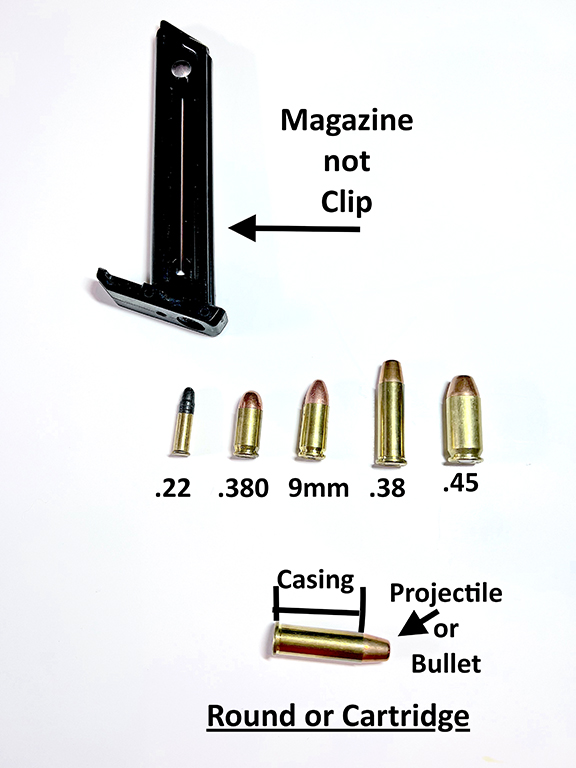Part 4: Confusing terms for semi-automatics

By MARJ LAW

A friend at the Wakulla County Sheriff’s Office range is confused.
“A guy told me I need more clips for my Sig Sauer P238 380,” she said. “Why do I need clips? Don’t I need magazines?”
“Yes,” I reply. “You do need magazines for your Sig. Some people have used the word ‘clip’ as interchangeable with a ‘magazine.’ They are not the same thing.”
AMMOTOGO says: “The magazine holds the cartridges, stores them, and feeds them into the chamber of the firearm. A clip is simply a storage device you use to load ammunition into the magazine of a firearm.”
Basically, then, those of us using semi-automatic handguns will be using magazines. And therefore, her Sig P238 uses magazines.
“OK, tell me something else,” she asks. “A guy corrected me when I said I wanted a box of bullets. He said I want rounds or cartridges. Which do I want?”
When you look at your piece of ammunition, you see something that has a casing, and has some sort of a “nose.” These two parts form a round or cartridge. The nose part is the projectile, or the bullet that flies out of the gun towards your target. The metal casing will fly out of your ejection port to the ground. Therefore, the bullet is a part of a round and the casing is the other part. You do want to pick up rounds or cartridges for your gun.
“I will remember to ask for a box of rounds and I’ll buy an extra magazine, not a clip, for my Sig.
“But I still have questions. I need 9mm bull – no, I mean rounds – for my new 9mm Glock. Which 9mm rounds? The shelves at the gun store have 9s, but they say: 9x17, 9x18, and 9x19 rounds. They also have words like Luger, Parabellum and NATO. This is confusing. What does my 9mm Glock want?”
“The 9x17 is also known as the .380 ACP. It’s also called a 9mm Short, Kurz or Corto. The diameter of the casing is almost but not exactly the same as the 9mm round and the casing is shorter. Diameter is important because rounds won’t feed properly into the gun. It’s confusing, but use the .380 in your Sig P238.
“The 9x18 is a Soviet-designed round used primarily in a gun called the Makarov. You cannot use it in your Glock because although the diameter of the casing is almost the same, it is 1/10th of a millimeter fatter, and the casing’s length is again different. It is not compatible with loading and feeding your round. “
Most 9mm handguns sold here in the U.S. use 9x19 rounds. They also go by the name Luger and Parabellum. A “hotter” round is the NATO round. Your gun must be able to handle this more powerful military round, or the higher pressure could damage your gun.
“This means you want 9mm Luger or Parabellum for your Glock.”
“OK. Now I want to know about naming different guns. Why do they call some like a .22, others like a 9mm and others like a .40-caliber gun? Why don’t they all say either millimeter or caliber?”
“Yes, that is confusing. 9mm handguns stem from guns first made in Europe. Europe uses the metric system: hence 9mm. Somehow, that didn’t change when the guns came here.
If you see a .45-caliber handgun, it was first made in America. The .45 is .45 inches diameter of the bullet. Remember, the bullet is the projectile, not the entire round and not the casing.”
“It’s a good thing a .22 is a .22,” she says. “Then you only have to purchase .22 rounds.”
“What if your gun is a .22 Magnum?” I ask.
“What’s a .22 Magnum?” she wonders.
“It’s a round with a longer casing and it’s more powerful than your .22.”
“Geez. One more thing to know.” She looks a bit disgusted. “And why don’t they name calibers like 9, 10, 11, 12 and 13?”
“That sure would seem easier. However, like we said before, some of the guns were manufactured in different countries and they use the metric system. Just because the guns have come to America or they are now being made here, the original appellation still stands.”
“Oh. I’ve heard of the .22 and the .25. Is a .25-caliber handgun stronger and better than a .22?”
I debate in my mind.
“Yes, a .25 will have a little more powder and be a bit more powerful.”
“Then why do so many of my friends have .22s?”
“.22s are fine learner guns. They have much less recoil or ‘kick’ than others. If you’re not worried about recoil, you’ll spend your energies on learning your grip, how to aim, and how to squeeze and not yank the trigger.
“A .25 also has a light recoil, but have you looked at the price of .25 ammunition? It’s a lot higher than the .22 ammunition. Some guns of different calibers are not sold a lot here. Because ammunition is made in large quantities, manufacturers can price the most-used ammunition at lower cost. You probably don’t want to buy a gun that is of an odd caliber. You’ll pay more for ammo and you might not even be able to find ammo for it very readily.”
“So what semi-automatic handguns sell the most often in America?”
“Most people buy .22s, .380s, 9s, .38s, 10s, .40s and .45s.”
“Which are best for newbies?”
“Newbies find .22s, .380s, and 9s the easiest to handle.”
“My boyfriend says I should get a .45 because it has more ‘take-down’ power,” she says.
“Yes, he’s right,” I agree. “However, since you are carrying your gun in your purse, and .45-caliber rounds are large and require more space, would you really want to carry the gun in your purse? Also, the .45 has a much much stronger recoil than either your .380 or your 9mm. Have you tried out anyone’s .45?”
“Yes. I tried a Springfield .45. It was kinda small but… wow! What a kick! My boyfriend likes it a lot.”
“Would you practice with it at the range? Would you be happy shooting it over and over?”
“Heck, no!”
“Well, since you wouldn’t practice with it, would you be able to hit Mr. Bad if he were to come at one of your children?”
“Noooo.”
“Then do you need a .45?”
“Hmm. No.”
“I did try my girlfriend’s .38,” she offers. “It had a snub nose and fit in her purse but what an awful kick! Sally’s boyfriend put in something called ‘Wadcutters,’ which made the recoil easier, but I still don’t like the amount of kick.”
“If you ever would like a higher-caliber gun, then try one out. If you feel you can practice with it and can afford another gun, then go for it!”
“Can you handle your Sig .380 and your Glock?”
“Sure. I like going to the WCSO range and shooting paper targets.”
“Then you do have the best gun for you,” I reassure her.
Marj Law is the former director of Keep Wakulla County Beautiful who has become an avid shooter in retirement.
